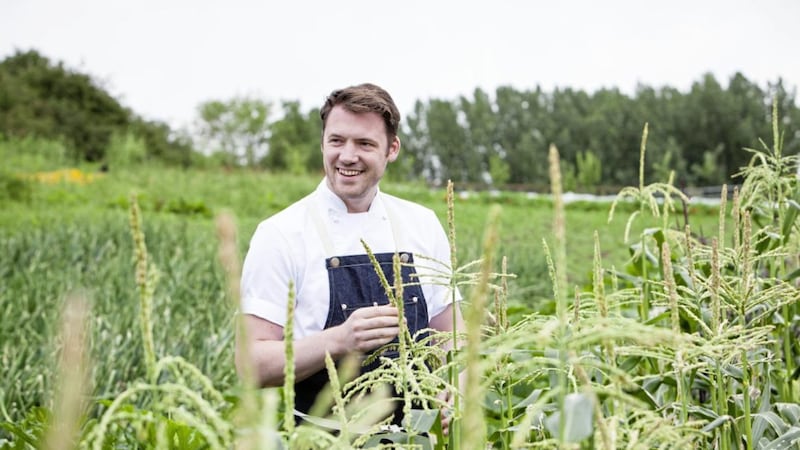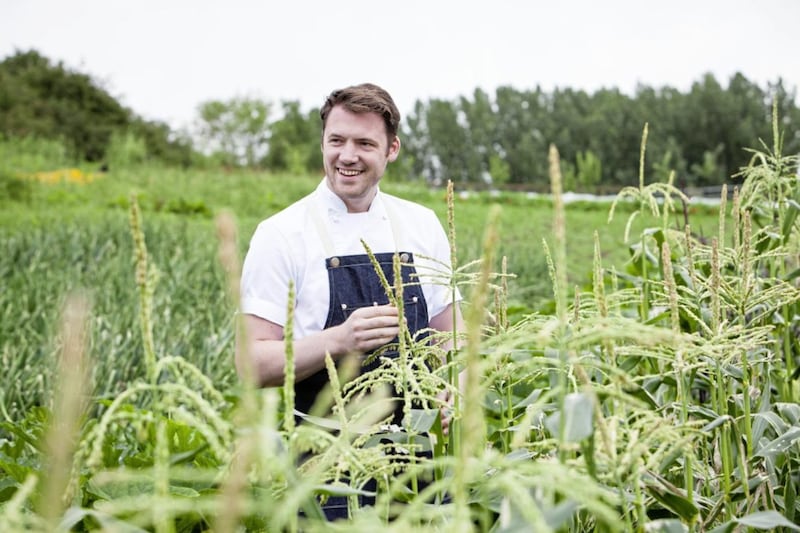FOR a chef who became Britain's youngest to earn a Michelin star at the age of 24, and twice triumphed on BBC Two show Great British Menu, Tommy Banks is remarkably self-effacing.
"I've still got so much to learn," he says. "I don't think I'm a particularly advanced cook."
Many would disagree. Banks runs the Black Swan, Oldstead in North Yorkshire, where he's been from the age of 17 (his parents own the pub), and became head chef in 2013, retaining the star it had won under previous head chef, Adam Jackson. But he felt fraudulent, as if the dishes weren't his.
Fast forward five years and Banks has gained a name for himself for his own inventive combinations – he prefers the term "making it all up as I go along" to 'self-taught' – using local produce and displaying them as though exquisite pieces of art on the plate. The Black Swan was voted the world's best restaurant on TripAdvisor in October 2017 and, now, it's always packed.
"Do people achieve things and manage to bask in it? I don't know if I'm different," he wonders, on the publication of his first cookbook, Roots. "Whenever I achieve something, there's also something else we've got to do."
Perhaps his feet are firmly on the ground because it hasn't always been easy. "Running a business in a rural place is really tough, it struggled," he admits, and aged 18 Banks became very ill with ulcerative colitis, had surgery and spent a year recovering.
"Winning Great British Menu was massive for my self-confidence. Before that, I thought what I was doing was good, but no-one else had really [experienced] it, because we were this tiny restaurant and we were quite quiet," says the 28-year-old, admitting he was "petrified and extremely anxious" going into the show, and how odd it was to be recognised afterwards. Now he's on the other side of things – this year's MasterChef finalists spent a day cooking with him.
Anyone who's seen his TV appearances will know he's steadfast in his ethos of home-grown produce and really using the ingredients on his doorstep – after all, farming is in his blood. Banks grew up on the farm his family still run in the "idyllic" rural, North York Moors.
As a result, his food is completely dictated by what's grown on the farm, so humble British (or more specifically, Yorkshire) veg always takes centre stage.
"It means you have to be creative," Banks says. "My menus are designed around what we've got coming in. So if we've got Jerusalem artichokes, beetroot and wild garlic, we won't just do vegetarian food, but whatever the fish or meat is going to be will have to go around what that is first. I'd never approach it like, 'I want to do a duck dish'. It's more like, 'I've got celeriac, what are we going to do with it this year?'"
Banks wants to dispel some of the misconceptions around 'seasonal' eating. "When I started growing produce, I realised there aren't really four seasons in the UK from a culinary perspective, because we literally have nothing ready in January to April, and most of May, depending on the weather." For instance, peas in supermarkets in spring are likely to be imported. "Spring is a time when everything is growing," he says, "We haven't even sown our peas yet! We'd lose them to frost."
It's only natural then that his cookbook reflects the farming seasons rather than the four seasons we all know. It's split into three sections – the hunger gap (January to May), time of abundance (June to September) and the preserving season (October to December).
The hunger gap (the "most challenging of the three seasons") is a time for humble onions and wild garlic to really shine, as well as Jerusalem artichokes, Yorkshire rhubarb ("the best in the world") and some foraged ingredients most won't have cooked with before – spruce, lovage and fir.
"The flavour is a bit like grapefruit, and yes, you have to put a lot of technique into making it taste delicious, but it's really good."
The first five months of the year also inspire his dishes that play with savoury and sweet – think artichoke fudge or scallops in rhubarb juice. "If you've only got root vegetables, you have to make them work," he says.
While the easy-to-make John Dory with young vegetables and lemon verbena stock is perfect for summer – the season of plenty.
The tail-end of the year, with it's earthy, irony veg like celeriac (seriously underrated according to Banks) and beetroot, is the time for preserving by fermenting or 'clamping', a process common during war rationing where tops are removed, roots buried in soil and kept in a cold, dry, dark place.
"Preserving is quite easy," Banks says. "It's an old technique that we've lost because we don't need it anymore, but I'd urge people to try and ferment vegetables, like kimchi or turnips. They're delicious and so easy. It sounds like a faddy, cheffy thing, but you literally put some vegetables in a jar with some salt and water, leave the jar, and you've got fermented vegetables."
:: Roots by Tommy Banks is published by Seven Dials, priced £25. Below are two recipes from the book for you to try.
TURBOT WITH STRAWBERRIES AND CREAM
(serves 4)
Equipment needed: Thermomix
150g chives
150ml grapeseed oil (available via Amazon)
150g green strawberries, cut into 2mm dice (if available, just use red ones if not)
150g red strawberries, cut into 2mm dice
150g golden beetroot, cut into 2mm dice
150g fennel bulb, cut into 2mm dice
150g white turnip, cut into 2mm dice
4 x 120g skinless turbot portions
Knob of butter
Sprinkle of fennel pollen (available via Amazon)
Sea salt
For the sauce:
2 shallots, sliced
10g butter
150ml dry white wine
150ml vermouth
300ml fish stock
300ml double cream
Sea salt
For the elderflower vinegar:
20 ripe elderflower heads
500ml Chardonnay vinegar
For the green herb oil:
500g green herb leaves (works best with strong, soft herbs like lovage or chives)
250ml grapeseed oil
Method
Make the green herb oil: Blitz the herbs in a food processor to a rough green slush. Tip this into a muslin cloth and work hard to squeeze out any water. Return the dry herb pulp to the blender. Heat the oil to 70C and blitz with the herbs until thoroughly combined. If your blender has a heating element you don't need to preheat the oil. Just blend the oil and herbs at 70°C for five minutes. Leave to marinate overnight before hanging oil in a muslin cloth over a bowl.
Make the elderflower vinegar: Check the elderflower for any bugs, then stuff them into a large jar and pour over the vinegar. Place the jar in a pan of water so the water covers the jar and bring to the boil. Turn off the heat and allow the jar to cool in the water before storing in the fridge.
For the sauce, sweat the shallots in the butter until they are soft but do not allow them to colour. Add the white wine and reduce over a medium heat until the wine is a syrup coating the shallots, then add the vermouth and reduce again.
Add the stock and reduce by half. Add the cream and again reduce by half. Check the seasoning and reserve for later. Put the chives in a food processor and blitz to a mush. Scrape the chives onto a clean cloth. Squeeze the chive mush in the cloth to remove water – you should end up with a dry ball. Place the dry chives and the grapeseed oil in a Thermomix jug. Blitz for seven minutes at 70C then strain through a muslin cloth.
Season the diced strawberries and vegetables with salt and dress in one tablespoon of the elderflower vinegar and one tablespoon of herb oil.
Roast the turbot in a pan with lots of foaming butter on a medium heat, placing it skin-side down, frying for one to two minutes on either side.
Heat up the cream sauce, add four dessert spoons of the chive oil and whisk it in – the white sauce should be marbled with bright green oil.
To serve, spoon the vegetable tartare (diced fruit and veg pieces) onto four plates, add the turbot and pour over the cream sauce. Sprinkle with fennel pollen to finish.
JERUSALEM ARTICHOKE FUDGE
(Makes 20 pieces)
4kg Jerusalem artichokes, peeled, to make 400g artichoke syrup
500g glucose
410ml whipping cream
225g butter
16g fine sea salt
20ml cider vinegar
200g milk chocolate, broken into pieces
Method
To make the syrup, roughly chop the artichokes and feed them through a juicer. Allow the juice to stand still for an hour, and skim off any foam that settles on top. Pass the juice through a double layer of damp muslin; bring to the boil in a large pot.
Over a medium heat, allow the juice to reduce at a steady simmer, continuously skimming off any scum, until you are left with a syrup roughly the colour of Marmite and a consistency similar to treacle when cooled.
Combine the artichoke syrup, glucose and whipping cream in a small pot and bring slowly to the boil, stirring to combine. When boiling, reduce to a medium simmer and cook until it reads 100C on a sugar thermometer.
Turn the heat down low and cook until the mixture reaches 112C, stirring. Remove the pan from the heat and immediately beat in the butter while the mixture is still hot, followed by the salt and vinegar.
Scrape the warm mixture into a deep roasting tin lined with baking parchment. Once the fudge is cool to the touch, transfer the tin to the freezer to set hard.
Remove from the freezer and use the baking parchment to lift the fudge out onto a chopping board. After 10 minutes or so at room temperature, use a large knife heated in hot water to cut the fudge first into 2cm wide strips, and then into squares.
Line up the fudge pieces on fresh parchment and return to the freezer for an hour. Melt the chocolate in a heatproof bowl set over a small pan of barely simmering water.
Using a fork, plunge the fudge squares one at a time into the chocolate to cover them completely, then knock off the excess chocolate by tapping the fork against the edge of the bowl. Replace the fudge in rows on the baking parchment and return to the freezer to set the chocolate.
To serve, remove the fudge from the freezer, trim any splattered chocolate edges with a paring knife, and allow to thaw in the fridge for 30 minutes.



